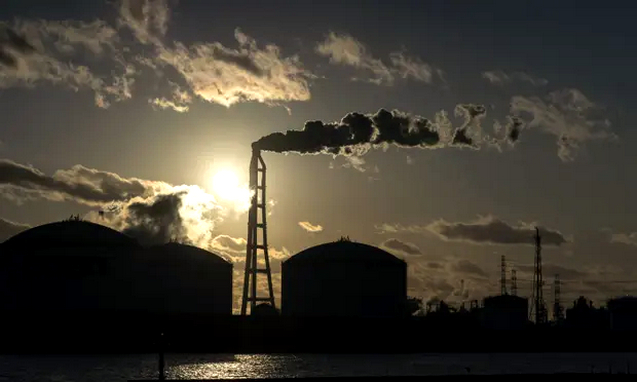Global economy could lose out by $600tn by end of century on current emissions targets
 |
| The study’s authors call their findings a ‘self-preservation strategy’ for government. Photograph: Tomohiro Ohsumi/Getty Images |
But if countries go no further than their current CO2 pledges – which are too weak to meet the goals of the Paris agreement, and would lead to dangerous levels of global heating – then they face steep economic losses.
The global economy would lose out by as much as $600tn (£476tn) by the end of the century, on current emissions targets, compared with its likely growth if countries meet the Paris goals, according to a paper published in the journal Nature Communications.
If countries fail even to implement their current plans – which would lead to an estimated 3C (5.4F) of heating, far beyond the 2C or 1.5C settled on as the limit of safety in the 2015 Paris agreement – then the outlook is even worse, with losses of up to $800tn by 2100, according to the report from a group of scientists from the Beijing Institute of Technology and other mainly Chinese institutions.
The study’s authors call their findings a
“self-preservation strategy” for governments. They calculated the
potential benefits by including the social welfare aspects of cutting
emissions and of economic growth, which gives more weight than some
other models to developing countries with large populations of poor and
vulnerable people. They found that better international cooperation on
emission would lead to better outcomes for such people, who are likely
to be worst affected by climate breakdown.The global economy would lose out by as much as $600tn (£476tn) by the end of the century, on current emissions targets, compared with its likely growth if countries meet the Paris goals, according to a paper published in the journal Nature Communications.
If countries fail even to implement their current plans – which would lead to an estimated 3C (5.4F) of heating, far beyond the 2C or 1.5C settled on as the limit of safety in the 2015 Paris agreement – then the outlook is even worse, with losses of up to $800tn by 2100, according to the report from a group of scientists from the Beijing Institute of Technology and other mainly Chinese institutions.
However, their findings also show such a strategy has greater benefits for developing countries with high emissions, such as India, Indonesia, Nigeria and China, than for developed countries such as the US and the EU in the medium term, though all benefit in the longer term.
Their findings come at a critical time for governments around the world grappling with the coronavirus crisis, and its dire economic impacts. Many are under pressure to ignore or roll back previous commitments on the climate, and some stricken industries with high emissions – such as airlines and carmakers – have lobbied for a weakening of green measures. Oil producers have called a truce in their price war.
But reneging on green commitments now only stores up future problems, and will hasten climate breakdown, scientists have warned, and any respite from rising emissions caused by the crisis will be only temporary. All countries are supposed to come forward with improved national plans on curbing greenhouse gas emissions this year, before vital UN climate talks aimed at keeping the Paris agreement on track.
The UN and the UK government have been forced to delay the talks, called Cop26, until next year. That gives governments more time to improve their national plans, called nationally determined contributions in the UN jargon, but so far there is little sign they are doing so. Only Japan and Chile, the host of last year’s talks, among major countries have so far submitted fresh plans, and while Chile agreed to step up climate action, Japan’s plan showed no improvement.
A UK government spokesperson for Cop26 told the Guardian: “We welcome Chile’s climate leadership as Cop25 president in submitting a strengthened emissions reduction target, and hope to see all countries following their lead.”
Current climate plans showed that the rich world must do more, said Rachel Kennerley, climate campaigner at Friends of the Earth. “Budgets should be rebalanced to provide emergency finance and help poorer nations – it’s the fair and right thing to do. If we don’t pay now, this is the kind of bill that, like a person ignoring a credit card statement, will only multiply in time.
“And it’s the kind of expenditure that repays multiple benefits and should really be seen as a smart investment. As if stopping climate change isn’t enough, it will deliver a better quality of life for more people around the world, faster.”
The economic benefits of curbing greenhouse gas emissions, compared with the high costs of reneging, should spur governments to act on the climate, according to the Nature study’s authors. However, investments are needed to realise these gains, particularly from developed countries. The outlay would amount to between $5tn and $33tn for the US, and between $16tn and $105tn for the G20 countries as a whole.
The study said: “Early and quick action will provide a better chance to close the widening emissions gap, even though a large amount of abatement cost would occur in the short term.”
Links
- Carbon emissions from fossil fuels could fall by 2.5bn tonnes in 2020
- Cop26 climate talks in Glasgow postponed until 2021
- Campaigners attack Japan's 'shameful' climate plans release
- 'It's a nightmare': Fife residents demand inquiry into flaring at petrochemical plant
- EU member states call for 2030 climate target
- UN predicts above-average temperatures even without El Niño
- World may miss carbon targets unless big firms improve – Mark Carney
- JP Morgan economists warn climate crisis is threat to human race




